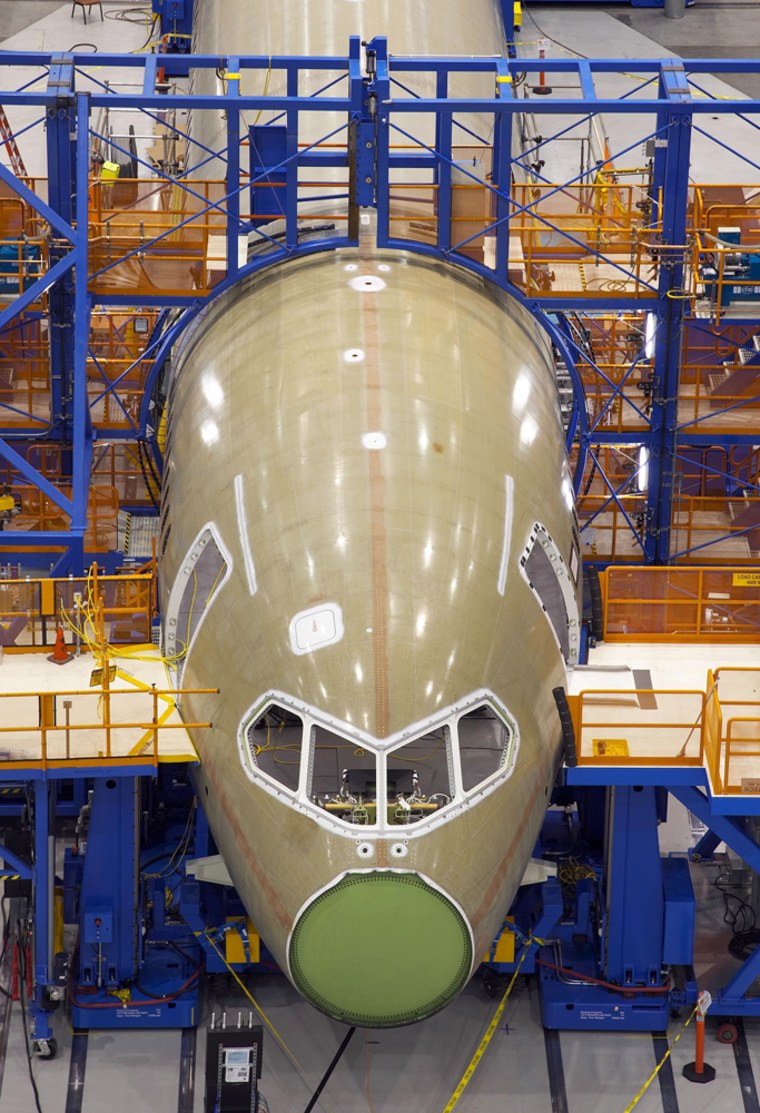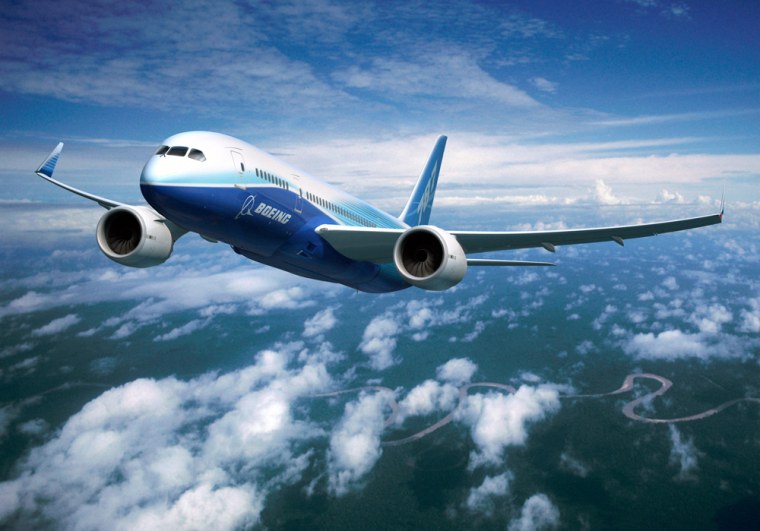After five years under wraps, the future of commercial aviation is about to make its worldwide debut.
The global spotlight will be shining on The Boeing Co. July 8 (07-08-07) as it unveils its newest passenger jet in 13 years: the 787 Dreamliner. It hasn’t even flown yet and already the 787 is making aviation history as the world’s hottest-selling and most technically advanced new commercial jet ever.
Not since Boeing ushered in the jet age with its 707 in 1954 has there been such hoopla over a new passenger airplane. For the 787 — the company’s first all-new jet since the 777 was unveiled in 1994 — Boeing has rented an entire football field to simulcast the rollout, which will be emceed by broadcaster Tom Brokaw.
While the Dreamliner — the world’s first commercial jet made primarily of plastic — is ready for its public debut on the ground, the airplane still must prove itself in the air. First flight is scheduled for September, followed by a series of certification test flights this fall and commercial service in May 2008 with All Nippon Airways of Japan. Boeing will have six 787s in test flights by the end of this year.
As a 91-year-old patriarch of aviation, Boeing is no stranger to risk. But not only is Boeing betting the company on its $10 billion Dreamliner program, it is breaking new ground on how and where commercial airplanes will be designed, built and flown for generations to come. Even the material used to build the 787 is setting new industry wide standards. Instead of using aluminum, Boeing is relying on manmade carbon-fiber-reinforced plastic, known as composite, for the entire airframe.
“This is the next evolutionary step in aviation,’’ says aviation consultant Scott Hamilton of Issaquah, Wash.-based Leeham Co. “It’s a game-changer for its manufacturing and assembly processes and will probably be mimicked by succeeding airplanes.’’
In what Boeing describes as the world’s biggest and most sophisticated industrialized project ever, the 787 program has taken more than a million hours of supercomputer design work involving hundreds of aerospace workers from every corner of the globe.

Instead of designing and building the commercial jet itself, as Boeing traditionally has done, the company has evolved into an Erector-set assembler of sorts, farming out 70 percent of the 787 work to nearly 50 partners and top-tier suppliers at 135 sites spanning four continents.
Boeing is giving its overseas suppliers much more than a slice of the manufacturing pie, in exchange for lucrative aircraft orders. For the 787, Boeing includes the recipe too: wide responsibilities — including financial risk — for designing and building major sections of the jet, which are then flown to Boeing’s final assembly plant in Everett, Wash., where they are essentially snapped together. That’s a humbling first for the once-arrogant company that vowed never to give up wing design and production.
Boeing is using sophisticated Dassault database management software that allows all of the 787 work sites to be “virtually linked” 24 hours a day, 365 days a year, ensuring that everyone works out of the same database with one set of drawings.
“The 787 not only will revolutionize air travel, it represents a new way of building airplanes,’’ says Scott Strode, 787 vice president of Airplane Definition and Production.
Gone are the noisy factory floors with handkerchief-clad mechanics clanging away on shiny metal. Today’s 787 “manufacturing technicians” carry hand-held computers with airplane specs that aid in joining together major airplane sections — fuselage, wings, horizontal stabilizer and vertical fin – in cleaner, quieter assembly bays.
Final assembly began May 21 when prefabricated aircraft sections were flown in on cargo versions of Boeing’s 747 jumbo jets, called Dreamlifters. Boeing itself only produces the composite vertical fin with risk-sharing partners producing the rest of the airplane: wings coming from Japan, fuselage sections via Italy and South Carolina, landing gear from France, rudder sections from China and engines from Britain and the U.S.
“This is a far cry from how Boeing used to make airplanes,’’ says Hamilton.
The first few weeks of final assembly have not been smooth. Some of the jet’s major structures were delivered incomplete and fuselage sections didn’t fit together properly. In addition, temporary fasteners were being used to hold fuselage sections together because of an industry-wide shortage of permanent fasteners.
Boeing officials have acknowledged the problems and characterize them as “hiccups” in the production process that are being resolved as soon as they crop up.
Company officials, however, are keeping a watchful eye on their international partners to ensure the aircraft sections are delivered on time. Any more missteps or delays could end up in a disastrous domino effect, forcing Boeing to postpone the 787’s first flight. Just last month, Vought Aircraft, one of Boeing’s major partners on the 787, fired a top executive because of production snafus and delays on fuselage sections.
Mike Bair, head of the 787 program, told reporters recently that the production snafus have been resolved and are typical for all-new airplane programs. He denied a JP Morgan analyst's report that the 787 production schedule may slip four months, saying the program is still on schedule. “We are where we need to be,’’ he told reporters.
Boeing’s bold new manufacturing strategy is a sore point for the company’s largest union, whose contract with Boeing expires in the summer of 2008, just a few months after the 787's first delivery.

Union members, who haven’t forgiven Boeing for moving its headquarters to Chicago and who lobbied hard to keep 787 final assembly in Washington state, view the Dreamliner as a mixed blessing. “There’s excitement and yet there’s anger,” says Tom Wroblewski, District president of the International Association of Machinists and Aerospace Workers.
The twin-engine jet, which was launched in April 2004, represents a revolutionary comeback for Boeing, which many industry insiders had written off just a few years ago when the company decided to forgo building a super jumbo jet to compete with its European rival, Airbus' double-decker A380.
Instead of giant, metal cruise ships in the sky, Boeing gambled on a smaller, fuel-efficient plastic jet that could fly longer, non-stop routes. That bet has so far paid off. The Dreamliner is sold out until 2013 with 643 orders worth an estimated $100 billion from 45 airline customers.
Boeing’s airline customers have been attracted to the 787 on promises of a 20 percent increase in fuel efficiency, 30 percent less maintenance costs and an unprecedented range for a mid-size airplane of 8,000 miles — the diameter of the Earth at the equator — allowing airlines to fly fast-growing, non-stop routes between the United States, Asia and Europe.
“Nobody is questioning the company now,’’ says aviation analyst Hamilton.
Boeing is counting on the Dreamliner to cement its world dominance in its longstanding battle with Airbus over what Boeing predicts is a $2.8 trillion market for commercial airplanes over the next 20 years.
Airbus, which had an impressive showing at last month’s Paris Air Show, is fighting back with a newly designed A350 jet, which also will rely heavily on composites.
While Boeing’s 787 is on track for rollout and first flight, the company must still prove to the world, and scrutinizing Federal Aviation Administration officials, how well the airplane flies.
Success on the 787 program “remains to be seen,’’ says Hamilton. Just as Airbus' reputation has been tarnished by production problems that caused a two-year delay in its A380 super jumbo program, Boeing’s reputation is at risk if its 787 doesn’t perform as promised.
“Only time will tell,’’ says Ray Jaworowski, senior aerospace analyst with Newton, Conn.-based Forecast International.
